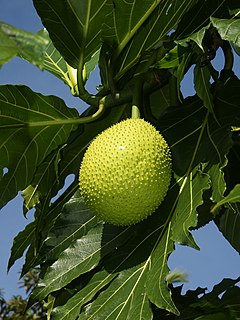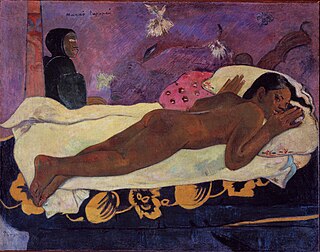Related Research Articles

Breadfruit is a species of flowering tree in the mulberry and jackfruit family (Moraceae) believed to be a domesticated descendant of Artocarpus camansi originating in New Guinea, the Maluku Islands, and the Philippines. It was initially spread to Oceania via the Austronesian expansion. It was further spread to other tropical regions of the world during the Colonial Era. British and French navigators introduced a few Polynesian seedless varieties to Caribbean islands during the late 18th century. Today it is grown in some 90 countries throughout South and Southeast Asia, the Pacific Ocean, the Caribbean, Central America and Africa. Its name is derived from the texture of the moderately ripe fruit when cooked, similar to freshly baked bread and having a potato-like flavor.

The Polynesian narrative or Polynesian mythology encompasses the oral traditions of the people of Polynesia together with those of the scattered cultures known as the Polynesian outliers. Polynesians speak languages that descend from a language reconstructed as Proto-Polynesian - probably spoken in the Tonga - Samoa area around 1000 BC.
Māui (Maui) is the great culture hero and trickster in Polynesian mythology. Very rarely was Māui actually worshipped, being less of a deity and more of a folk hero. His origins vary from culture to culture, but many of his main exploits remain relatively similar.
Samoan mythology tells stories of many different deities. There were deities of the forest, the seas, rain, harvest, villages, and war. There were two types of deities, atua, who had non-human origins, and aitu, who were of human origin.

In Hawaiian mythology, Laka is the name of two different popular heroes from Polynesian mythology.. Lengthy legends of their exploits extend throughout the islands, and the kings of Tahiti and Hawaiʻi claimed them as their ancestors.
Arawa was one of the great ocean-going, voyaging canoes in Māori traditions that was used in the migrations that settled New Zealand.

Satawal is a solitary coral atoll of one island with about 500 people on just over 1 km2 located in the Caroline Islands in the Pacific Ocean. It forms a legislative district in Yap State in the Federated States of Micronesia. Satawal is the easternmost island in the Yap island group and is located approximately 70 kilometres (43 mi) east of Lamotrek.
In Māori tradition, Matahourua was the canoe of the legendary hero Kupe, who, in some accounts, was the discoverer of Aotearoa.
Various Māori traditions recount how their ancestors set out from their homeland in waka hourua, large double-hulled ocean-going canoes (waka). Some of these traditions name a mythical homeland called Hawaiki.
The Polynesian Society is a non-profit organisation based at the University of Auckland, New Zealand, dedicated to the scholarly study of the history, ethnography, and mythology of Oceania.

In Hawaiian religion, Māui is a culture hero and ancient chief who appears in several different genealogies. In the Kumulipo, he is the son of ʻAkalana and his wife Hina-a-ke-ahi (Hina). This couple has four sons, Māui-mua, Māui-waena, Māui-kiʻikiʻi, and Māui-a-kalana. Māui-a-kalana's wife is named Hinakealohaila, and his son is named Nanamaoa. Māui is one of the Kupua. His name is the same as that of the Hawaiian island Maui, although native tradition holds that it is not named for him directly, but instead named after the son of Hawaii's discoverer.
Alingano Maisu, also known as Maisu, is a double-hulled voyaging canoe built in Kawaihae, Hawaii by members of Na Kalai Waʻa Moku o Hawaiʻi and ʻOhana Wa'a members from throughout the Pacific and abroad as a gift and tribute to Satawalese navigator Mau Piailug, who navigated the voyaging canoe Hōkūleʻa on her maiden voyage to Tahiti in 1976 and has since trained numerous native Hawaiians in the ancient art of wayfinding. The word maisu comes from the Satawalese word for breadfruit that has been knocked down by storm winds and is therefore available for anyone to take. The name is said to symbolize the knowledge of navigation that is made freely available.

Makemo, Rangi-kemo or Te Paritua, is an atoll in the Tuamotu archipelago in French Polynesia. It measures 69 km in length and 16.5 km in width, giving it a land area of 56 km². It is the fourth largest atoll of the Tuamotu Archipelago in terms of lagoon surface, with a lagoon of 603 km² in area. Its lagoon has two navigable passes.
Kakaʻalaneo was the Moʻi of Maui. He was the titular chieftain or king of the island of Maui.

Artocarpeae is a tribe within the plant family Moraceae. It includes 7 to 12 genera and 70 to 87 species including Artocarpus altilis, the breadfruit.

In Hawaiian mythology, Kū or Kūkaʻilimoku is one of the four great gods. The other three are Kanaloa, Kāne, and Lono. Feathered god images or ʻaumakua hulu manu are considered to represent Kū. Kū is worshiped under many names, including Kū-ka-ili-moku, the "Snatcher of Land". Kūkaʻilimoku rituals included human sacrifice, which was not part of the worship of other gods.

There was widespread belief in ghosts in Polynesian culture, some of which persists today. After death, a person's ghost would normally travel to the sky world or the underworld, but some could stay on earth. In many Polynesian legends, ghosts were often involved in the affairs of the living. Ghosts might also cause sickness or even invade the body of ordinary people, to be driven out through strong medicines.

Tahiti and Society Islands mythology comprises the legends, historical tales, and sayings of the ancient people of the Society Islands, consisting of Tahiti, Bora Bora, Raiatea, Huahine, Moorea and other islands. It is considered a variant of a more general Polynesian mythology, developing its own unique character for several centuries. The religion was officially suppressed in the 19th century, and ultimately abandoned by the natives in favor of Christianity.
Niue is an island in the Southern Pacific, mostly inhabited by Polynesians. The plantations are mostly filled with manioc, taro and breadfruit, but banana trees can be found. The wide range of exotic plants in Niue includes taros, pawpaw, coconuts, bananas, yams, cassavas and breadfruits: All are intensively used in the local cuisine.
References
- ↑ Brown, John Macmillan (1907). Maori and Polynesian: Their Origin, History, and Culture. Hutchinson & Co. pp. 100& 294.
Vaitakere -wikipedia.
- ↑ "The Ancestry of the Polynesians came to Java a — Century or two before our Era, and there — changed Rice for Breadfruit as their Staple". Victoria University of Wellington . p. 100. Retrieved 2020-08-03.
| This article relating to a myth or legend from Oceania is a stub. You can help Wikipedia by expanding it. |